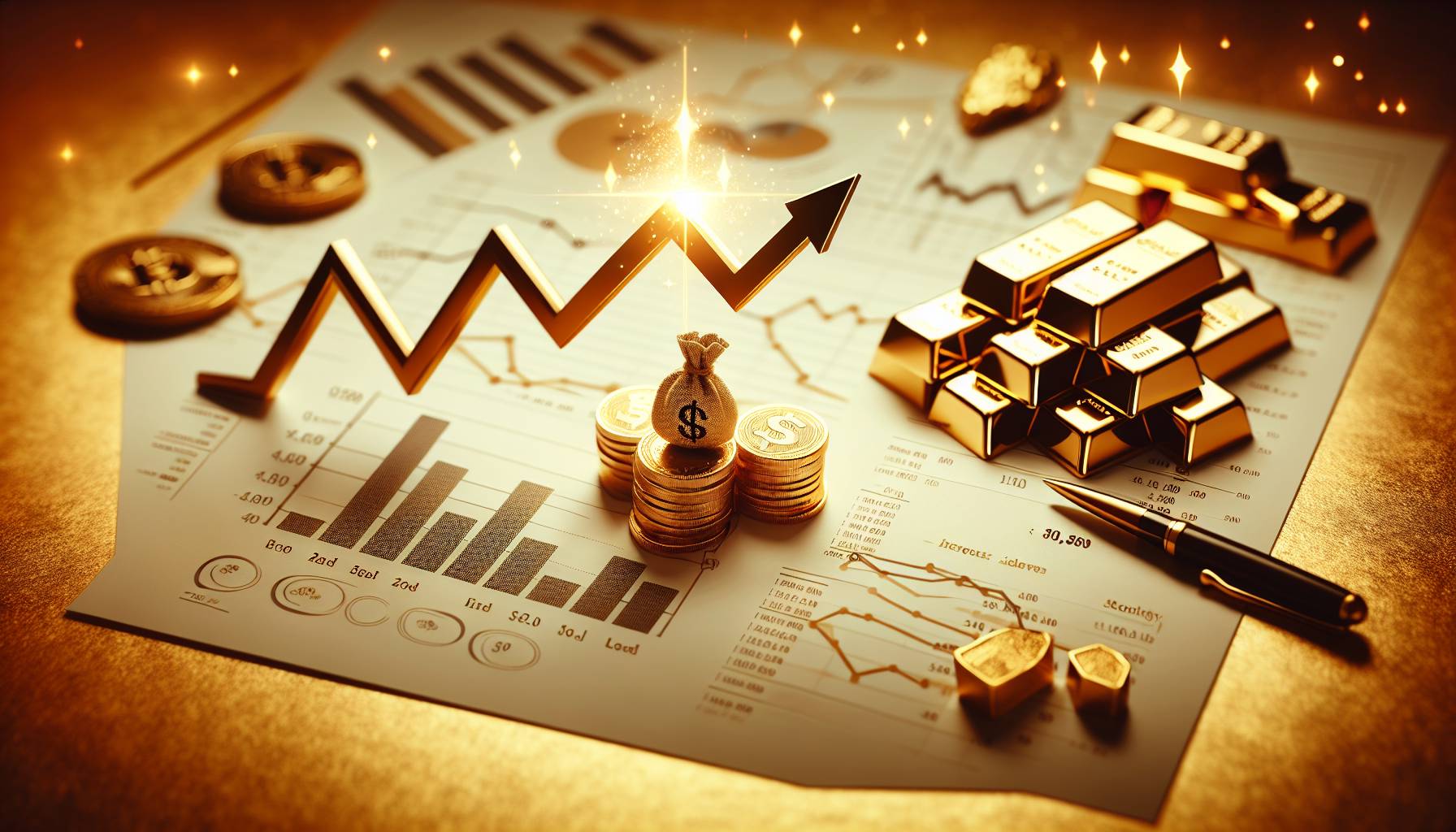Factors driving the surge in gold prices
The remarkable 29% increase in gold prices in 2025 can be attributed to several key factors. One of the primary drivers was the heightened geopolitical tensions that created uncertainty in global markets. Investors often turn to gold as a safe haven during times of instability, leading to increased demand and, consequently, higher prices.
Another significant factor was the persistent inflationary pressures experienced worldwide. As inflation erodes the purchasing power of fiat currencies, gold becomes an attractive store of value. In 2025, many economies faced rising inflation rates, prompting both institutional and individual investors to increase their gold holdings.
Additionally, central banks played a crucial role in the surge of gold prices. Several central banks, particularly in emerging markets, continued to diversify their reserves by increasing their gold holdings. This trend not only supported the price of gold but also signaled confidence in its long-term value.
Furthermore, the weakening of the US dollar throughout the year contributed to the rise in gold prices. Since gold is priced in US dollars, a weaker dollar makes gold cheaper for holders of other currencies, thereby boosting demand.
Lastly, technological advancements and the growing interest in sustainable and ethical investments also influenced gold prices. The increased use of gold in technology, particularly in electronics and renewable energy sectors, added to its demand. Meanwhile, the focus on ethical sourcing and environmentally friendly mining practices resonated with socially conscious investors, further driving interest in gold.
Comparison with other asset classes
In 2025, gold’s performance outshone all other asset classes, marking a significant shift in investment trends. While equities experienced volatility due to fluctuating economic conditions and geopolitical uncertainties, gold provided a stable alternative. The stock market, particularly in sectors sensitive to economic cycles, faced challenges that hindered substantial gains, making gold’s steady rise more appealing to investors.
Real estate, traditionally a robust investment, encountered hurdles as interest rates fluctuated and regulatory changes impacted property markets. These factors contributed to a more cautious approach among investors, who found gold’s consistent appreciation a more reliable option during the year.
In contrast, the bond market struggled with low yields and inflationary pressures, diminishing its attractiveness. As inflation eroded fixed-income returns, investors sought refuge in gold, which historically maintains its value against inflationary trends. This shift highlighted gold’s role as a hedge against economic instability and currency devaluation.
Cryptocurrencies, often touted as digital gold, faced their own set of challenges in 2025. Regulatory scrutiny and market volatility led to unpredictable price swings, causing some investors to reconsider their positions. In comparison, gold’s tangible nature and established market presence offered a sense of security that digital assets could not match.
Gold’s impressive performance in 2025 underscored its enduring appeal as a safe haven asset. Its ability to outperform other asset classes during a year marked by uncertainty and change reinforced its status as a cornerstone of diversified investment portfolios.
Implications for investors and the market
The significant rise in gold prices in 2025 has profound implications for investors and the broader market. For investors, the surge underscores the importance of diversification and the role of gold as a hedge against economic uncertainty. As gold outperformed other asset classes, it highlighted the necessity for a balanced portfolio that includes assets capable of weathering market volatility and inflationary pressures.
Institutional investors, in particular, may reassess their asset allocation strategies to incorporate a higher percentage of gold. This shift could lead to increased demand for gold-related financial products, such as exchange-traded funds (ETFs) and gold mining stocks, providing new opportunities for investment managers and financial advisors to offer tailored solutions to their clients.
For individual investors, the rise in gold prices serves as a reminder of the asset’s historical resilience and its potential to preserve wealth over time. As economic conditions remain unpredictable, individuals may consider increasing their exposure to gold, either through direct ownership or investment in gold-backed securities, to safeguard their financial future.
In the broader market, the surge in gold prices may influence central bank policies and monetary strategies. Central banks, particularly those in emerging markets, might continue to bolster their gold reserves as a means of stabilizing their currencies and protecting against external economic shocks. This trend could further support gold prices and reinforce its status as a critical component of national reserves.
Moreover, the increased focus on sustainable and ethical investing could drive further interest in gold sourced from environmentally responsible and socially conscious mining operations. Investors seeking to align their portfolios with their values may prioritize gold investments that adhere to these principles, potentially reshaping industry practices and standards.
The implications of the 2025 gold price surge extend beyond immediate financial gains, prompting a reevaluation of investment strategies and market dynamics. As investors and institutions navigate this evolving landscape, gold’s enduring appeal as a safe haven asset remains a pivotal consideration in the pursuit of long-term financial stability and growth.
factors driving the surge in gold prices
In 2025, gold prices experienced a remarkable surge of 29%, driven by a confluence of factors that captured the attention of investors worldwide. One of the primary catalysts was the heightened geopolitical tensions, which historically have led investors to seek the safety of gold as a hedge against uncertainty. Additionally, inflationary pressures played a significant role, as central banks around the globe continued to implement expansive monetary policies, leading to concerns about currency devaluation.
Moreover, the demand for gold was bolstered by increased purchases from central banks, particularly in emerging markets, as they sought to diversify their reserves away from traditional currencies. This strategic shift was complemented by a robust demand from the jewelry sector, especially in countries like India and China, where cultural and economic factors fueled consumption.
Another critical factor was the technological advancements in mining and refining processes, which, while increasing supply, also highlighted the finite nature of gold resources, thus enhancing its appeal as a long-term investment. The combination of these elements created a perfect storm, propelling gold to outperform other asset classes in 2025.
comparison with other asset classes in 2025
In 2025, gold’s impressive 29% price increase set it apart from other asset classes, marking it as the standout performer in the investment landscape. While equities faced volatility due to economic uncertainties and fluctuating interest rates, gold’s stability and historical reputation as a safe haven attracted investors seeking refuge from market turbulence.
Real estate, traditionally a strong contender, experienced slower growth as rising interest rates impacted affordability and demand. In contrast, gold’s liquidity and ease of access made it an attractive alternative for investors looking to diversify their portfolios without the complexities associated with property investments.
Commodities such as oil and agricultural products faced their own challenges, with supply chain disruptions and geopolitical factors causing unpredictable price swings. Gold, however, maintained its allure by offering a hedge against inflation and currency fluctuations, which were prevalent concerns throughout the year.
Cryptocurrencies, often touted as digital gold, saw significant volatility, with regulatory pressures and market corrections affecting investor confidence. Gold’s tangible nature and established market presence provided a sense of security that digital assets struggled to match.
Gold’s performance in 2025 underscored its enduring value and appeal, reinforcing its status as a cornerstone of diversified investment strategies. Its ability to outshine other asset classes highlighted the unique advantages it offers in times of economic uncertainty and market instability.

